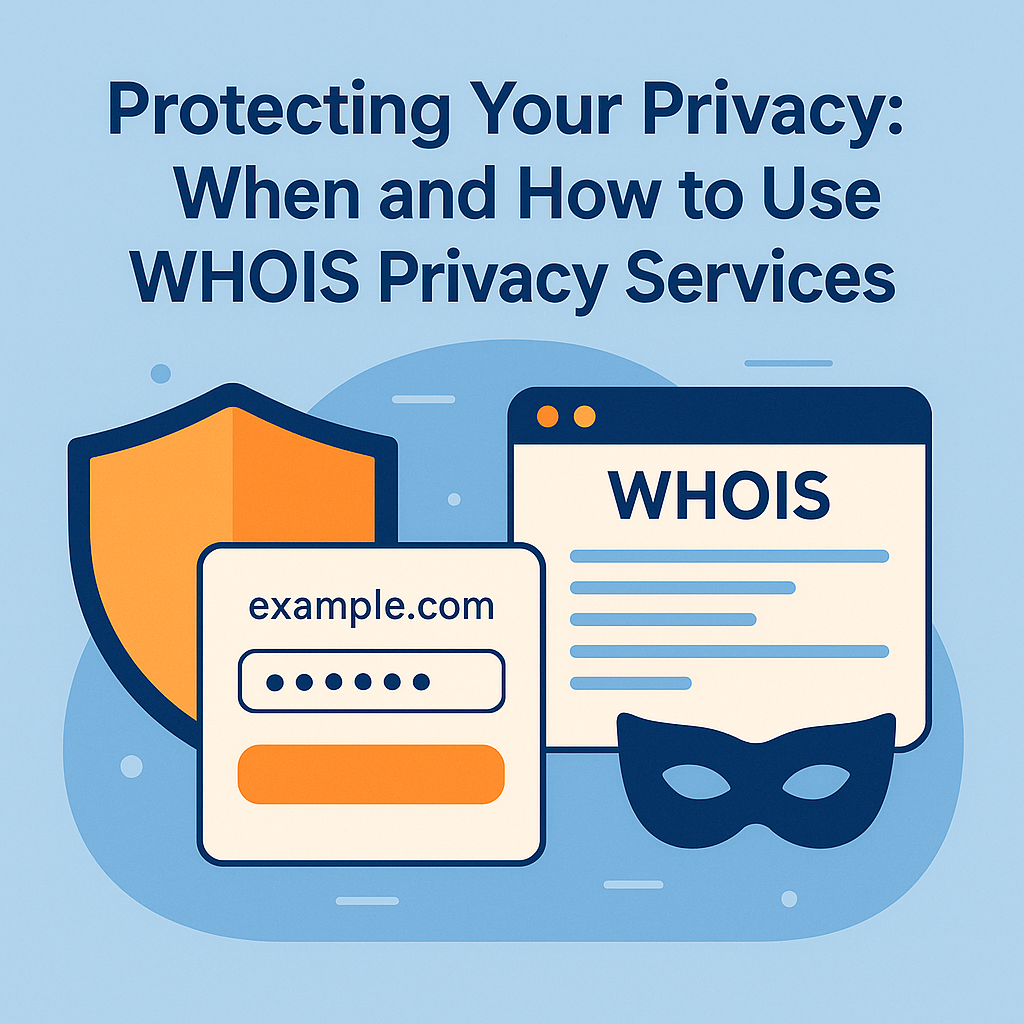Your domain name is your digital real estate. WHOIS records—publicly accessible information about your domain’s owner, registration dates, contact details, and name servers—help networks route traffic and stakeholders verify legitimacy. But if you run a small business or personal blog, exposing your name, email, phone number, and address to the whole world can be unsettling. That’s where WHOIS privacy services come in: they mask your personal data, replacing it with proxy or privacy service details. Yet privacy services aren’t one-size-fits-all: there are trade-offs, costs, and even legal nuances to consider. In this guide, we’ll explore:
- What WHOIS privacy services do
- When you really need them—and when you don’t
- How to set them up with popular registrars
- Potential pitfalls and legal considerations
- Automating privacy checks and renewals
- Real-world scenarios and best practices
By the end, you’ll know exactly how and when to use WHOIS privacy services to protect yourself and your brand.
What Are WHOIS Privacy Services?
When you register a domain through a registrar (like GoDaddy, Namecheap, or Cloudflare), you must provide contact information: name, organization, mailing address, phone number, and email. ICANN mandates that this data be publicly available via WHOIS lookups. Privacy services work by:
- Masking Your Data
They replace your personal contact fields with proxy details (typically the privacy provider’s name, address, and email). - Forwarding Communications
Emails sent to the privacy address are forwarded to your real inbox; phone calls or postal mail are usually filtered or forwarded per the service’s terms. - Maintaining Compliance
The service ensures ICANN requirements are met without exposing your info.
Under the hood, privacy services act as registrant (the official owner) in WHOIS, but behind the scenes you legally retain ownership. Think of it like using a P.O. box instead of your home address.
When You Should Use WHOIS Privacy Services
While defaulting to privacy seems wise, there are situations where exposing WHOIS data is beneficial. Evaluate based on:
1. Personal vs. Corporate Domains
- Personal Blogs / Small Sites: If privacy is paramount—for example, you blog about sensitive topics, or you simply don’t want spam—enable privacy.
- Corporate or Brand Domains: Larger companies often publish corporate contact details for transparency. Investors, legal partners, and customers may expect to reach out via WHOIS-published channels.
2. Risk of Harassment or Spam
- High-Risk Content: Sites discussing politics, religion, health, or controversial topics may attract harassment or doxing.
- Email & Telemarketers: Privacy services shield the contact info that scrapers harvest for spam or cold calls.
3. Legal and Regulatory Requirements
- GDPR & Privacy Laws: If you’re in the EU or handling EU personal data, hosting personal data in WHOIS might conflict with GDPR. Privacy services can help blur some compliance lines (though registrars must still disclose data to law enforcement when required).
- Domain Disputes & UDRP: Public registrant data can aid challengers in Uniform Domain-Name Dispute-Resolution Policy cases. In some defensive scenarios, it may help to have your real details visible to show good faith registration.
4. Transfer and Renewal Scenarios
- Domain Transfers: Some registrars restrict transfers when privacy is enabled. You might need to temporarily disable privacy to move domains.
- Renewal Notifications: Privacy can intercept or delay renewal notices. Setting up automatic renewals is crucial to avoid accidental expiry when using privacy.
How to Enable WHOIS Privacy (Step-by-Step)
The process varies by registrar, but core steps remain:
Namecheap
- Log in → Domain List
- Click Manage next to your domain
- Under Contact Information, toggle WHOIS Privacy to “On”
- Confirm and pay any annual fee (usually $2–$4/domain)
GoDaddy
- Sign in → My Products
- Find domain → Click Manage DNS
- Under Contact Information, select Privacy & Protection
- Choose a privacy plan and complete checkout
Cloudflare
- Add domain → Cloudflare DNS (free plan includes privacy)
- Navigate to Registrar → Whois Privacy → Enable
- No extra cost but requires Cloudflare Registrar
Other Registrars
- Look for “WHOIS Privacy,” “Domain Privacy,” or “Privacy Protection” in the domain management interface.
- Some offer free privacy (e.g., Name.com, Porkbun); others charge annually.
- Always review renewal pricing—introductory prices can jump in year two.
Potential Pitfalls and Legal Nuances
- Law Enforcement Access
Privacy providers often have an agreement to reveal your real info to police, courts, or ICANN in case of subpoenas. It’s not a fortress—just a filter. - Accidental Lockouts
- Forgot your registrar login email? If your contact is hidden, password-reset messages may go to the privacy proxy and get lost.
- Tip: Ensure you set up an administrative email separate from WHOIS.
- Expiration Notices
Privacy often hides your WHOIS email, so rely on registrar dashboard notifications or set up calendar reminders. - SSL Certificates & CAA Records
Some certificate authorities validate domain ownership via WHOIS email. Privacy can break automatic validations—manually approve validations or whitelist WHOIS privacy addresses. - Brand and SEO Considerations
Competitors may question your legitimacy if your domain’s WHOIS shows a privacy proxy. Some B2B partners expect to verify your identity via WHOIS; adjust based on audience.
Automating Privacy Checks and Renewals
Managing dozens—or hundreds—of domains manually is error-prone. Here’s how to streamline:
WHOIS Privacy Status API
FastDNSCheck.com offers an API endpoint to check privacy status:
GET https://fastdnscheck.com/api/whois-privacy?domain=example.com
Response:
{"domain":"example.com","privacy_enabled":true,"provider":"Namecheap"}
Automate with Scripts
Example Python:
import requests, datetime
domains = ["example.com","myblog.net"]
for d in domains:
res = requests.get(f"https://fastdnscheck.com/api/whois-privacy?domain={d}").json()
if not res["privacy_enabled"]:
print(f"{d} has no privacy enabled—consider enabling!")
Schedule this weekly via cron; email alerts to [email protected] if any domain unexpectedly loses privacy.
Bulk Renewals
- Use registrar’s bulk renewal tools.
- Enable auto-renew where possible.
- Maintain a spreadsheet / database of renewal dates, privacy status, and registrar notes.
Real-World Example: Balancing Privacy and Trust
A boutique law firm launched a blog on sensitive legal issues. They enabled WHOIS privacy to avoid harassment, but lost out on potential client inquiries because prospective clients used WHOIS to verify legitimacy. Their solution:
- Dual Contact Channels: Publicly listed professional email on website and in DNS records via
domain.com/contact. - Partial Privacy: Shared organization name (not personal partner names) in WHOIS while hiding individual emails/phones.
- Registrar Lock: Ensured
clientTransferProhibitedstatus to prevent hijacking. - Regular Audits: Monthly scripts checked privacy status and registrar locks.
This hybrid approach protected partners’ personal details while preserving corporate transparency.
FAQs on WHOIS Privacy Services
Q: Does privacy service hide all fields?
A: Typically, name, email, phone, and address are masked; registrar and nameservers remain visible.
Q: Are privacy services legal?
A: Yes—ICANN rules allow privacy proxies. However, abuse policies require providers to reveal real data to law enforcement under due process.
Q: Can I use different privacy providers per domain?
A: Yes. You might prefer free privacy at one registrar and premium features (like legal forwarding) at another.
Q: How do I disable privacy for transfers?
A: Most registrars let you toggle privacy off in the domain settings—do this before requesting an EPP auth code.
Q: Will WHOIS privacy affect GDPR compliance?
A: GDPR mandates shielding personal data; WHOIS privacy helps, but registrars must still comply with data subject rights and possibly reveal info to authorities.
Protecting your privacy through WHOIS services is a critical layer in your domain management strategy. Evaluate your needs—personal vs corporate, customer expectations, and legal landscape—then choose the right privacy service and automate checks. By balancing confidentiality with credibility, you can keep spam at bay, avoid doxing, and maintain trust with your audience. If you spot any domain without privacy or need help automating checks, shoot us an email at [email protected]—we’re here to help keep your digital identity secure!


